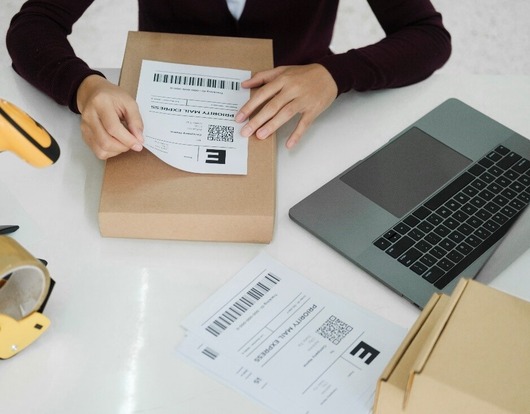Shipping labels play a crucial role in the logistics and delivery process, serving as a key identifier for packages in transit. In this blog, we’ll delve into the significance of shipping labels, explore various types of printers used for label creation, discuss best practices for effective shipping, break down the essential elements of a shipping label, and explore different methods for label creation.
Exploring Types of Shipping Label Printers
- Inkjet and Laser Printers
Inkjet Printers use liquid ink to create images on various surfaces, allowing for versatile color printing capabilities.
Pros:
- Versatility: Inkjet and laser printers are versatile and commonly found in office settings, making them accessible for small businesses.
- Color Printing: Inkjet printers allow for color printing, enabling the inclusion of branding elements and enhancing label visibility.
- Affordability: Traditional printers are often more cost-effective for businesses with lower shipping volumes.
Cons:
- Durability: Labels produced by inkjet printers may be susceptible to smudging and damage, especially in humid or wet conditions.
- Speed: While laser printers are generally faster, inkjet printers might lag in terms of printing speed.
- Thermal Printers
Thermal Printers utilize heat to produce images on special thermal paper, resulting in efficient and durable monochromatic labels.
Pros:
- Durability: Thermal labels are known for their durability, being resistant to smudging, fading, and environmental factors.
- Speed: Thermal printers operate at high speeds, ideal for businesses with high shipping volumes, ensuring swift label production.
- Cost-Effective: Thermal printing eliminates the need for ink or toner, resulting in lower long-term operational costs.
Cons:
- Monochromatic Printing: Thermal printers typically produce monochromatic labels, limiting the inclusion of color for branding purposes.
- Upfront Cost: The initial investment for a thermal printer might be higher compared to traditional inkjet or laser printers.
Elaborating on Efficiency and Benefits of Thermal Printers
Thermal printers utilize heat to produce images on special thermal paper. This process offers several key benefits:

Consistency:
Thermal printing provides consistent, high-quality prints without the variability seen in inkjet or laser printing.
Longevity:
Thermal labels are resistant to fading and deterioration over time, ensuring that shipping information remains legible throughout the entire transit process.
Reduced Maintenance:
With no need for ink or toner cartridges, thermal printers often require less maintenance, reducing downtime and operational disruptions.
Environmentally Friendly:
Thermal printing is considered more environmentally friendly as it eliminates the need for consumables like ink cartridges, reducing waste.
Choosing the right printer, such as thermal printers, aligns with the efficiency goals of businesses like BlueRose Packaging. The durability, speed, and cost-effectiveness of thermal printing can enhance the overall shipping process, ensuring that BlueRose Packaging maintains its commitment to excellence in packaging and delivery services.
Best Shipping Label Practices for 2024
In the dynamic landscape of shipping, adopting best practices for labeling is paramount to ensuring smooth and efficient logistics. Here’s an elaboration on key practices for 2024:

- Strategic Placement:
- Importance: Placing shipping labels in easily visible and secure locations on packages is crucial for efficient processing and delivery. Clear visibility facilitates quick identification and sorting, reducing the risk of errors in the logistics chain.
- Considerations: Labels should be affixed to flat surfaces, avoiding edges or corners where they could be easily damaged. Additionally, ensuring that labels are placed uniformly across packages enhances the overall professional presentation.
- Enhanced Protection:
- Measures: Protecting shipping labels from damage during transit and adverse weather conditions is essential for maintaining the integrity of crucial shipping information. Encasing labels in transparent, weather-resistant labels or utilizing adhesive protectors shields them from rain, snow, or rough handling.
- Materials: Consider using high-quality label stock and adhesives resistant to moisture, ensuring labels remain securely attached throughout the shipping process.
- Effective Use of Waybills:
- Significance: Waybills play a pivotal role in streamlined tracking and information retrieval. Including waybills with pertinent details aids in the efficient monitoring of shipments, offering a comprehensive overview of the package’s journey from origin to destination.
- Contents: Waybills should contain essential information such as sender and recipient details, package contents, and tracking numbers. This not only assists in logistics but also provides transparency to customers regarding their shipment’s status.
- Incorporating Special Instructions:
- Value: Including special handling instructions on shipping labels is invaluable for ensuring that packages receive the necessary care during transit. This is particularly crucial for fragile items or those with specific storage requirements.
- Examples: Clearly stating instructions such as “Fragile,” “Handle with Care,” or “Keep Upright” can prevent mishandling and minimize the risk of damage. Tailoring instructions to the nature of the shipment enhances the chances of successful, damage-free delivery.
In navigating the complexities of modern shipping, adhering to these best practices fosters a seamless and reliable process. Implementing strategic label placement, ensuring protection against external elements, utilizing waybills effectively, and incorporating special instructions collectively contribute to a robust and customer-centric shipping strategy in 2024.
Deconstructing the Elements of a Shipping Label
Efficient shipping labels are not just stickers on packages; they are a detailed communication tool that facilitates the seamless movement of goods. Let’s delve into the key components that make up a shipping label:

- Sender Information:
- Importance: Including the sender’s name and return address is crucial for effective communication. This information not only ensures the sender can be contacted if necessary but also aids in the return process, enhancing overall logistics efficiency.
- Recipient Details:
- Significance: Accurate recipient information is paramount for successful deliveries. Clear and precise details, including the recipient’s name, address, and contact information, reduce the risk of misdelivery or delays and contribute to a positive customer experience.
- Service Level Indication:
- Explanation: Service level indicators, such as standard, express, or priority, on shipping labels convey the urgency and priority of the shipment. This information guides logistics providers in allocating resources appropriately, ensuring timely deliveries based on customer expectations.
- Tracking Barcodes:
- Significance: Tracking barcodes and numbers are the backbone of real-time package monitoring. These unique identifiers enable accurate tracking throughout the shipping journey, providing both businesses and customers with visibility into the location and status of the package at any given moment.
- Package Dimensions and Weight:
- Relevance: Specifying package dimensions and weight on shipping labels is essential for logistical planning. This information aids in optimizing storage space, calculating shipping costs, and ensuring that the package is handled appropriately during transit, preventing damage.
- Product Descriptions and Receiver Information:
- Emphasis: Clear and concise product descriptions, along with receiver information, contribute to accurate sorting and delivery. Including details about the contents helps logistics providers handle packages with care, especially when special instructions or handling requirements are necessary.
- Branding:
- Role: Branding on shipping labels extends beyond mere aesthetics; it establishes a professional and consistent image. Incorporating logos, brand colors, or other visual elements reinforces brand recognition and can positively impact the perception of the shipped products.
Creating Shipping Labels
Efficiently creating shipping labels involves leveraging various methods and tools. Let’s delve into the specifics of each approach:

- Carrier Websites: Services provided by platforms such as BlueRose Packaging, DHL, UPS, Amazon FBA, FedEx, and eBay shipping empower users to generate shipping labels directly on their respective websites. This feature proves beneficial, particularly for businesses with a relatively modest monthly shipment volume. Rather than repeatedly inputting all shipment data into the website, users can conveniently create shipping labels within the platform. However, it’s noteworthy that when relying on this method, the shipping company is required to manually update customers on order tracking details.
- Shipping Label Software Solutions: Dedicated shipping label software solutions bring automation and efficiency to the label creation process. These tools offer a range of benefits, including the ability to streamline bulk label generation, integrate seamlessly with existing business systems, and provide advanced features like address validation and shipping cost calculations.
Shipping Label Software: Platforms such as Linnworks, Loftware NiceLabel, Loftware Spectrum, MarkMagic, and Maestro Label Designer provide solutions for businesses dealing with a higher monthly shipment volume. - Shipping Tools: Various tools are available to simplify the shipping label creation process. Online platforms that aggregate shipping services and plugins integrated into e-commerce platforms are among the options. These tools typically feature user-friendly interfaces, allowing businesses to input shipment details, compare carrier rates, and generate labels efficiently. The availability of such tools contributes to a smoother shipping process and is particularly beneficial for businesses managing multiple carriers and shipping options.
- Manual Writing: While technology has introduced automated label creation methods, manual writing remains a viable option in specific scenarios. This approach might be suitable for businesses with lower shipping volumes or those facing unique situations where automated solutions are not cost-effective.
Conclusion
In the realm of logistics, shipping labels are the unsung heroes ensuring packages reach their destinations seamlessly. This exploration emphasized their significance, dissected printer options, and highlighted crucial 2024 best practices. For businesses like BlueRose Packaging, the efficiency of thermal printing aligns perfectly with their commitment to excellence. As we look ahead, strategic label placement, enhanced protection, optimal use of waybills, and special instructions emerge as keystones for error-free logistics. BlueRose Packaging’s dedication echoes in every label, underscoring a commitment to quality and precision in the complex dance of packaging and delivery.
Shipping Labels FAQs
Q: Why are shipping labels so important?
A: Shipping labels serve as crucial identifiers in the logistics process, facilitating the smooth tracking and delivery of packages.
Q: What are the key differences between Inkjet and Laser Printers for shipping labels?
A: Inkjets excel in color versatility, but laser printers boast speed. Keep in mind, though, that inkjet labels may sacrifice some durability.
Q: Why consider Thermal Printers for shipping labels?
A: Thermal printers provide efficient, durable, and cost-effective monochromatic labels, ideal for businesses with high shipping volumes.
Q: What are the best practices for shipping labels in 2024?
A: Key practices include strategic label placement, enhanced protection, effective use of waybills, and incorporating special instructions for precise and reliable logistics.
Q: How does BlueRose Packaging leverage thermal printing for shipping efficiency?
A: BlueRose Packaging aligns with the durability, speed, and cost-effectiveness of thermal printing, ensuring a superior shipping experience.

